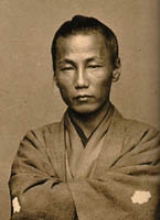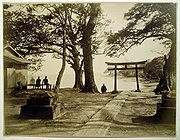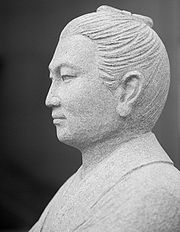
Ueno Hikoma
Encyclopedia

Japan
Japan is an island nation in East Asia. Located in the Pacific Ocean, it lies to the east of the Sea of Japan, China, North Korea, South Korea and Russia, stretching from the Sea of Okhotsk in the north to the East China Sea and Taiwan in the south...
ese photographer, born in Nagasaki
Nagasaki
is the capital and the largest city of Nagasaki Prefecture on the island of Kyushu in Japan. Nagasaki was founded by the Portuguese in the second half of the 16th century on the site of a small fishing village, formerly part of Nishisonogi District...
. He is noted for his fine portrait
Portrait
thumb|250px|right|Portrait of [[Thomas Jefferson]] by [[Rembrandt Peale]], 1805. [[New-York Historical Society]].A portrait is a painting, photograph, sculpture, or other artistic representation of a person, in which the face and its expression is predominant. The intent is to display the likeness,...
s, often of important Japanese and foreign figures, and for his excellent landscapes, particularly of Nagasaki and its surroundings. Ueno was a major figure in nineteenth-century Japanese photography as a commercially and artistically successful photographer and as an instructor.
Background, youth, and preparation

Shimazu family
The were the daimyō of the Satsuma han, which spread over Satsuma, Ōsumi and Hyūga provinces in Japan.The Shimazu were identified as one of the tozama or outsider daimyō clans in contrast with the fudai or insider clans which were hereditary vassals or allies of the Tokugawa clan,The Shimazu were...
who in 1848 imported possibly the first camera in the country, a daguerreotype
Daguerreotype
The daguerreotype was the first commercially successful photographic process. The image is a direct positive made in the camera on a silvered copper plate....
camera for the Shimazu daimyō
Daimyo
is a generic term referring to the powerful territorial lords in pre-modern Japan who ruled most of the country from their vast, hereditary land holdings...
, Nariakira
Shimazu Nariakira
was a Japanese feudal lord of the Edo period, the 28th in the line of Shimazu clan lords of Satsuma Domain. He was renowned as an intelligent and wise lord, and was greatly interested in Western learning and technology...
.
Ueno Hikoma first studied Chinese classics
Chinese classic texts
Chinese classic texts, or Chinese canonical texts, today often refer to the pre-Qin Chinese texts, especially the Neo-Confucian titles of Four Books and Five Classics , a selection of short books and chapters from the voluminous collection called the Thirteen Classics. All of these pre-Qin texts...
; then in 1852, not long after his father's death, he entered the Nagasaki Medical College with a view to studying chemistry in order to help him run the family business, dealing in nitre and chintz dyeing. He eventually studied chemistry under the Dutch naval medical officer Johannes L. C. Pompe van Meerdervoort
J. L. C. Pompe van Meerdervoort
Johannes Lijdius Catharinus Pompe van Meerdervoort was a Dutch physician based in Nagasaki, Japan...
(1829–1908) after the latter's arrival in 1857. Pompe van Meerdervoort, who had a camera and photography manual though little experience as a photographer, also instructed Ueno Hikoma in photography.
It was only after his contact with Swiss photographer Pierre Rossier
Pierre Rossier
Pierre Joseph Rossier was a pioneering Swiss photographer whose albumen photographs, which include stereographs and cartes-de-visite, comprise portraits, cityscapes, and landscapes...
(1829 – ca. 1890) that Ueno decided to pursue a career as a photographer. Rossier had been commissioned by the firm Negretti and Zambra
Negretti and Zambra
The firm Negretti and Zambra was a producer of scientific and optical instruments and also operated a photographic studio based in London, England...
to photograph in Asia and he worked in Japan from 1859 to 1860. He was only in Nagasaki for a short time, but while there he taught wet-collodion process
Collodion process
The collodion process is an early photographic process. It was introduced in the 1850s and by the end of that decade it had almost entirely replaced the first practical photographic process, the daguerreotype. During the 1880s the collodion process, in turn, was largely replaced by gelatin dry...
photography to Ueno, Horie Kuwajirō
Horie Kuwajiro
Horie Kuwajirō was an early Japanese photographer and science writer.Horie studied rangaku, specifically chemistry, at the Nagasaki Naval Training Center where J. L. C. Pompe van Meerdervoort was an instructor. In addition to chemistry, Pompe van Meerdervoort taught photography...
(1831–1866), Maeda Genzō
Maeda Genzo
Maeda Genzō was a Japanese photographer from northern Kyūshū. In Nagasaki he studied photography under Jan Karel van den Broek and J. L. C. Pompe van Meerdervoort. Neither of these teachers was an experienced photographer, and their attempts to produce photographs were largely failures...
(1831–1906) and others. Soon after, Ueno's friend Horie bought a wet-plate camera and in 1861 Horie photographed Ueno at work in the Tsu clan's laboratory in Edo
Edo
, also romanized as Yedo or Yeddo, is the former name of the Japanese capital Tokyo, and was the seat of power for the Tokugawa shogunate which ruled Japan from 1603 to 1868...
(now Tokyo
Tokyo
, ; officially , is one of the 47 prefectures of Japan. Tokyo is the capital of Japan, the center of the Greater Tokyo Area, and the largest metropolitan area of Japan. It is the seat of the Japanese government and the Imperial Palace, and the home of the Japanese Imperial Family...
). In 1862 Ueno and Horie co-wrote a textbook titled Shamitsu kyoku hikkei that comprised translated extracts from ten Dutch science manuals and which included an appendix titled Satsueijutsu [The Technique of Photography] that described techniques of collodion process photography as well as Nicéphore Niépce
Nicéphore Niépce
Nicéphore Niépce March 7, 1765 – July 5, 1833) was a French inventor, most noted as one of the inventors of photography and a pioneer in the field.He is most noted for producing the world's first known photograph in 1825...
's asphalt printing method.
Career

Rangaku
Rangaku is a body of knowledge developed by Japan through its contacts with the Dutch enclave of Dejima, which allowed Japan to keep abreast of Western technology and medicine in the period when the country was closed to foreigners, 1641–1853, because of the Tokugawa shogunate’s policy of national...
, or the study of Western science. He decided to make a career as a photographer.
In the autumn of 1862 Ueno opened a commercial photographic studio
Photographic studio
A photographic studio is both a workspace and a corporate body. As a workspace it is much like an artist’s studio, but providing space to take, develop, print and duplicate photographs. Photographic training and the display of finished photographs may also be accommodated in a photographic studio...
by the Nakashima River in Nagasaki and he also began importing cameras. At first the business was unsuccessful, but it gradually grew, allowing the studio to move to a large and well-lit building in 1882, becoming popular with Japanese and foreign notables and receiving mention in guidebooks, in Edmond Cotteau's Un touriste dans l'Extrême-Orient (1884) and in Pierre Loti
Pierre Loti
Pierre Loti was a French novelist and naval officer.-Biography:Loti's education began in his birthplace, Rochefort, Charente-Maritime. At the age of seventeen he entered the naval school in Brest and studied at Le Borda. He gradually rose in his profession, attaining the rank of captain in 1906...
's novel, Madame Chrysanthème
Madame Chrysanthème
Madame Chrysanthème is an opera, described as a comédie lyrique, with music by André Messager to a libretto by Georges Hartmann and Alexandre André, after the semi-autobiographical Madame Chrysanthème by Pierre Loti...
(1887). The patronage of foreigners in turn greatly increased Ueno's income, which allowed him to use more expensive materials and to expand his studios. Still in the early days of this imported technology, Ueno overcame the reticence of many Japanese to be photographed and took portraits of such figures as Sakamoto Ryōma
Sakamoto Ryoma
was a leader of the movement to overthrow the Tokugawa shogunate during the Bakumatsu period in Japan. Ryōma used the alias .- Early life :Ryōma was born in Kōchi, of Tosa han . By the Japanese calendar, this was the sixth year of Tenpō...
, Itō Shunsuke
Ito Hirobumi
Prince was a samurai of Chōshū domain, Japanese statesman, four time Prime Minister of Japan , genrō and Resident-General of Korea. Itō was assassinated by An Jung-geun, a Korean nationalist who was against the annexation of Korea by the Japanese Empire...
, Takasugi Shinsaku
Takasugi Shinsaku
was a samurai from the Chōshū Domain of Japan who contributed significantly to the Meiji Restoration.He used the alias to hide his activities from the shogunate.-Early life:...
, and Katsu Kaishū
Katsu Kaishu
was a Japanese statesman, naval engineer during the Late Tokugawa shogunate and early Meiji period. Kaishū was a nickname which he took from a piece of calligraphy by Sakuma Shōzan. He went through a series of given names throughout his life; his childhood name was and his real name was...
. During their visits to Japan Ueno photographed Ulysses S. Grant
Ulysses S. Grant
Ulysses S. Grant was the 18th President of the United States as well as military commander during the Civil War and post-war Reconstruction periods. Under Grant's command, the Union Army defeated the Confederate military and ended the Confederate States of America...
in 1879 and the Russian crown prince (later Tsar Nicholas II
Nicholas II of Russia
Nicholas II was the last Emperor of Russia, Grand Prince of Finland, and titular King of Poland. His official short title was Nicholas II, Emperor and Autocrat of All the Russias and he is known as Saint Nicholas the Passion-Bearer by the Russian Orthodox Church.Nicholas II ruled from 1894 until...
) in 1891. With the help of such patronage, Ueno's studio operated until the end of the century.
Ueno had an important and close working relationship with Felice Beato
Felice Beato
Felice Beato , also known as Felix Beato, was an Italian–British photographer. He was one of the first people to take photographs in East Asia and one of the first war photographers. He is noted for his genre works, portraits, and views and panoramas of the architecture and landscapes of Asia and...
. When visiting Nagasaki, Beato used Ueno's studio and photographed his younger sister and acquaintances, amongst other residents of the city. Beato also photographed Ueno himself at the Daikōji temple and the two photographers apparently exchanged photographs. Ueno probably refined his technique during his contact with the experienced Beato. Two other foreign visitors to Japan who influenced Ueno were the Dutch photographer Konrad Walter Gratama, who added to Ueno's knowledge of chemistry in 1866, and the Austrian photographer Wilhelm Burger who seems to have taught photographic techniques to Ueno while also making use of Ueno's studio to take some stereographs during his visit to the country in 1869-1870.

Uchida Kuichi
was a pioneering Japanese photographer from Nagasaki. He was greatly respected as a portrait photographer and was the only photographer granted a sitting to photograph the Emperor Meiji....
(1844–1875), Tomishige Rihei
Tomishige Rihei
was an important 19th and early 20th century Japanese photographer. He was a pioneer of wet-plate photography in Japan and is noted for his excellent large-format, albumen landscapes. Tomishige is especially renowned in Kyūshū....
, Kameya Tokujirō
Kameya Tokujiro
was a pioneering, though now little-known, nineteenth-century Japanese photographer. Kameya's original surname was Abe ; he was adopted by a family named Kameya. He learned photography at Deshima, the Dutch enclave in the harbour of Nagasaki where physicians Jan Karel van den Broek and...
, (1837–1922), Nakajima Shinzō, Nagai Nagayoshi, Noguchi Jōichi, Nakajima Seimin, Tanaka, Morita Raizō, Kikizu Maturoku, and Ueno Yoshima. Ueno maintained a close relationship with Uchida, and following the latter's trip to Nagasaki in 1872 while photographing for the Emperor Meiji
Emperor Meiji
The or was the 122nd emperor of Japan according to the traditional order of succession, reigning from 3 February 1867 until his death...
their albums include several identical images that they presumably exchanged. Eventually, Ueno opened branches of his photographic studio in Vladivostok
Vladivostok
The city is located in the southern extremity of Muravyov-Amursky Peninsula, which is about 30 km long and approximately 12 km wide.The highest point is Mount Kholodilnik, the height of which is 257 m...
in 1890 and in Shanghai
Shanghai
Shanghai is the largest city by population in China and the largest city proper in the world. It is one of the four province-level municipalities in the People's Republic of China, with a total population of over 23 million as of 2010...
and Hong Kong
Hong Kong
Hong Kong is one of two Special Administrative Regions of the People's Republic of China , the other being Macau. A city-state situated on China's south coast and enclosed by the Pearl River Delta and South China Sea, it is renowned for its expansive skyline and deep natural harbour...
in 1891.
In addition to portraits, Ueno produced many images of Nagasaki and its surroundings. He also photographed the transit of Venus
Transit of Venus
A transit of Venus across the Sun takes place when the planet Venus passes directly between the Sun and Earth, becoming visible against the solar disk. During a transit, Venus can be seen from Earth as a small black disk moving across the face of the Sun...
across the sun in 1874 for an American astronomical observation mission. In 1877, the governor of Nagasaki prefecture, Kitajima Hidetomo, commissioned him to take battlefield photographs in southwest Japan during the Satsuma Rebellion
Satsuma Rebellion
The was a revolt of Satsuma ex-samurai against the Meiji government from January 29 to September 24, 1877, 9 years into the Meiji Era. It was the last, and the most serious, of a series of armed uprisings against the new government.-Background:...
. For this commission Ueno was paid ¥
Japanese yen
The is the official currency of Japan. It is the third most traded currency in the foreign exchange market after the United States dollar and the euro. It is also widely used as a reserve currency after the U.S. dollar, the euro and the pound sterling...
330 for 420 prints. He was accompanied on this job by Setsu Shinichi and Noguchi Jōichi.
He exhibited photographs in at least two World Expositions
World's Fair
World's fair, World fair, Universal Exposition, and World Expo are various large public exhibitions held in different parts of the world. The first Expo was held in The Crystal Palace in Hyde Park, London, United Kingdom, in 1851, under the title "Great Exhibition of the Works of Industry of All...
, the Vienna World Exposition of 1873
Weltausstellung 1873 Wien
]The Weltausstellung 1873 Wien was the large World exposition was held in 1873 in the Austria–Hungarian capital of Vienna. Its motto was Kultur und Erziehung ....
and the World Columbian Exposition of 1893 in Chicago
Chicago
Chicago is the largest city in the US state of Illinois. With nearly 2.7 million residents, it is the most populous city in the Midwestern United States and the third most populous in the US, after New York City and Los Angeles...
, at which he won an award for “Good Taste and Artistic Finish”.
At first Ueno practiced wet-plate photography, but by about 1877 he began using imported Belgian dry plates. In spite of the contemporary popularity of hand-coloured
Hand-colouring
Hand-colouring refers to any method of manually adding colour to a black-and-white photograph, generally either to heighten the realism of the photograph or for artistic purposes...
photographs, Ueno's photographs are usually uncoloured. Some of Ueno's negatives
Negative (photography)
In photography, a negative may refer to three different things, although they are all related.-A negative:Film for 35 mm cameras comes in long narrow strips of chemical-coated plastic or cellulose acetate. As each image is captured by the camera onto the film strip, the film strip advances so that...
were probably purchased at some point by the photographer Kusakabe Kimbei
Kusakabe Kimbei
Kusakabe Kimbei was a Japanese photographer. He usually went by his given name, Kimbei, because his clientele, mostly non-Japanese-speaking foreign residents and visitors, found it easier to pronounce than his family name....
, as these images appear in the latter's albums. Though he apparently did not regularly offer photograph albums, he seems to have made some albums by special request for foreign customers. Ueno considered French and American photographic techniques and materials (for example, paper and lenses) to be superior to those of the British, whose products he also complained were overpriced, noting that albumen paper sold (c. 1868) for 100 ryō
Ryo
Ryo may refer to:* The Japanese kana digraph ryo, ryō, or ryoh * Ryō , a gold piece in pre-Meiji era Japan worth about sixty monme or four kan...
per box.
Eight of Ueno's photographs can be found online from the Freer Gallery of Art
Freer Gallery of Art
The Freer Gallery of Art joins the Arthur M. Sackler Gallery to form the Smithsonian Institution's national museums of Asian art. The Freer contains art from East Asia, South Asia, Southeast Asia, the Islamic world, the ancient Near East, and ancient Egypt, as well as a significant collection of...
and Arthur M. Sackler Gallery
Arthur M. Sackler Gallery
The Arthur M. Sackler Gallery joins the Freer Gallery of Art to form the Smithsonian Institution's national museums of Asian art. The Sackler celebrates its twenty-fifth anniversary in 2012....
Archives.
Commemoration
In 2000 the “Kyushu Sangyo University Photo Contest” established the “Ueno Hikoma Award” to commemorate the 40th anniversary of the founding of Kyushu Sangyo UniversityKyushu Sangyo University
was founded in 1960 in Fukuoka City, and currently has twenty departments and six graduate schools. It is a private university.-Undergraduate Faculties and departments:*Faculty of Economics**Department of Economics*Faculty of Commerce**Department of Commerce...
. The award is intended to discover and nurture emerging photographers.

